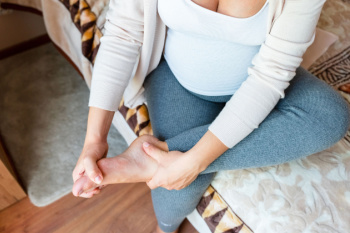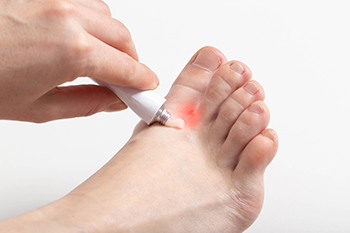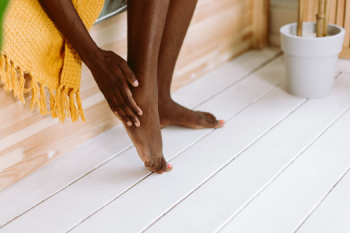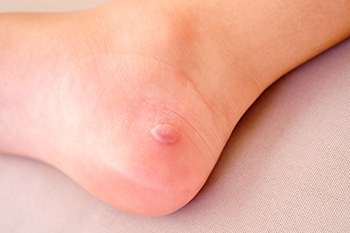Items filtered by date: July 2024
What Are Hammer or Claw Toes?

Hammer toes are a common foot deformity where one or more toes bend abnormally at the middle joint, resembling a hammer. Symptoms include pain, corns, and calluses due to friction against shoes. Preventing hammer toes involves wearing shoes with roomy toe boxes, avoiding high heels, and regularly stretching toes and feet. Treatment options vary based on severity, ranging from padding and orthotic inserts to alleviate discomfort to exercises and splinting to straighten the toe. In advanced cases, surgery may be necessary to correct the toe's position. A podiatrist can provide a comprehensive assessment, recommend appropriate treatments, and offer personalized advice to manage symptoms and prevent progression. Early intervention can improve comfort and prevent the need for more invasive treatments down the road. If you notice persistent toe pain, stiffness, or changes in toe shape, it is suggested that you make an appointment with a podiatrist.
Hammertoe
Hammertoes can be a painful condition to live with. For more information, contact one of our podiatrists from Palmetto Podiatry Group of Anderson. Our doctors will answer any of your foot- and ankle-related questions.
Hammertoe is a foot deformity that affects the joints of the second, third, fourth, or fifth toes of your feet. It is a painful foot condition in which these toes curl and arch up, which can often lead to pain when wearing footwear.
Symptoms
- Pain in the affected toes
- Development of corns or calluses due to friction
- Inflammation
- Redness
- Contracture of the toes
Causes
Genetics – People who are genetically predisposed to hammertoe are often more susceptible
Arthritis – Because arthritis affects the joints in your toes, further deformities stemming from arthritis can occur
Trauma – Direct trauma to the toes could potentially lead to hammertoe
Ill-fitting shoes – Undue pressure on the front of the toes from ill-fitting shoes can potentially lead to the development of hammertoe
Treatment
Orthotics – Custom made inserts can be used to help relieve pressure placed on the toes and therefore relieve some of the pain associated with it
Medications – Oral medications such as anti-inflammatories or NSAIDs could be used to treat the pain and inflammation hammertoes causes. Injections of corticosteroids are also sometimes used
Surgery – In more severe cases where the hammertoes have become more rigid, foot surgery is a potential option
If you have any questions please contact our office located in Anderson, SC . We offer the newest diagnostic and treatment technologies for all your foot and ankle needs.
Understanding Foot Pain During Pregnancy

Pregnancy is a time of profound physical changes, and foot pain can be a common discomfort experienced by many expecting mothers. Several factors contribute to foot pain during pregnancy, including weight gain, hormonal changes, and the body's altered center of gravity. As the uterus expands and the baby grows, additional pressure is placed on the feet, leading to swelling and discomfort. Hormonal changes, particularly increased levels of relaxin, can loosen ligaments and joints in the feet, making them more susceptible to strain and injury. Furthermore, changes in posture and gait due to the shifting center of gravity can put added stress on the feet, leading to pain and fatigue. Additionally, pre-existing foot conditions, such as flat feet or overpronation, may become more problematic during pregnancy. While foot pain during pregnancy is often temporary and resolves after childbirth, supportive footwear, practicing regular foot exercises, and elevating the feet can help alleviate discomfort and promote foot health. If you have developed foot pain during your pregnancy, it is suggested that you consult a podiatrist who can provide you with effective relief tips.
Pregnant women with swollen feet can be treated with a variety of different methods that are readily available. For more information about other cures for swollen feet during pregnancy, consult with one of our podiatrists from Palmetto Podiatry Group of Anderson. Our doctors will attend to all of your foot and ankle needs.
What Foot Problems Can Arise During Pregnancy?
One problem that can occur is overpronation, which occurs when the arch of the foot flattens and tends to roll inward. This can cause pain and discomfort in your heels while you’re walking or even just standing up, trying to support your baby.
Another problem is edema, or swelling in the extremities. This often affects the feet during pregnancy but tends to occur in the later stages.
How Can I Keep My Feet Healthy During Pregnancy?
- Wearing orthotics can provide extra support for the feet and help distribute weight evenly
- Minimize the amount of time spent walking barefoot
- Wear shoes with good arch support
- Wear shoes that allow for good circulation to the feet
- Elevate feet if you experience swelling
- Massage your feet
- Get regular, light exercise, such as walking, to promote blood circulation to the feet
If you have any questions please feel free to contact our office located in Anderson, SC . We offer the newest diagnostic and treatment technologies for all your foot and ankle needs.
Athlete’s Foot Relief and Prevention Tips
 Athlete's foot, or tinea pedis, is a common fungal infection affecting the skin of the feet, typically occurring between the toes. There are three main types of athlete’s foot, which are interdigital, moccasin, and vesicular. Interdigital athlete's foot typically occurs between the toes and is characterized by itching, scaling, and sometimes maceration of the skin. Moccasin athlete's foot affects the soles and sides of the feet, presenting as dry, thickened, and scaly skin that can sometimes crack. Vesicular athlete's foot features fluid-filled blisters, often appearing on the instep, and can cause intense itching and discomfort. The infection is caused by dermatophytes, which are fungi that thrive in warm, moist environments like locker rooms, public showers, and swimming pools. Risk factors include wearing tight, non-breathable footwear, sweating heavily, and walking barefoot in damp communal areas. Symptoms include itching, burning, peeling, and cracked skin, often accompanied by redness and blisters. Athlete's foot is extremely contagious and can spread through direct contact with infected skin or contaminated surfaces. Treatment involves antifungal medications, available as creams, sprays, or oral prescriptions, depending on the severity. If you have athlete’s foot, it is strongly suggested that you visit a podiatrist who can effectively treat the infection, which often includes prescribed medication.
Athlete's foot, or tinea pedis, is a common fungal infection affecting the skin of the feet, typically occurring between the toes. There are three main types of athlete’s foot, which are interdigital, moccasin, and vesicular. Interdigital athlete's foot typically occurs between the toes and is characterized by itching, scaling, and sometimes maceration of the skin. Moccasin athlete's foot affects the soles and sides of the feet, presenting as dry, thickened, and scaly skin that can sometimes crack. Vesicular athlete's foot features fluid-filled blisters, often appearing on the instep, and can cause intense itching and discomfort. The infection is caused by dermatophytes, which are fungi that thrive in warm, moist environments like locker rooms, public showers, and swimming pools. Risk factors include wearing tight, non-breathable footwear, sweating heavily, and walking barefoot in damp communal areas. Symptoms include itching, burning, peeling, and cracked skin, often accompanied by redness and blisters. Athlete's foot is extremely contagious and can spread through direct contact with infected skin or contaminated surfaces. Treatment involves antifungal medications, available as creams, sprays, or oral prescriptions, depending on the severity. If you have athlete’s foot, it is strongly suggested that you visit a podiatrist who can effectively treat the infection, which often includes prescribed medication.
Athlete’s Foot
Athlete’s foot is often an uncomfortable condition to experience. Thankfully, podiatrists specialize in treating athlete’s foot and offer the best treatment options. If you have any questions about athlete’s foot, consult with one of our podiatrists from Palmetto Podiatry Group of Anderson. Our doctors will assess your condition and provide you with quality treatment.
What Is Athlete’s Foot?
Tinea pedis, more commonly known as athlete’s foot, is a non-serious and common fungal infection of the foot. Athlete’s foot is contagious and can be contracted by touching someone who has it or infected surfaces. The most common places contaminated by it are public showers, locker rooms, and swimming pools. Once contracted, it grows on feet that are left inside moist, dark, and warm shoes and socks.
Prevention
The most effective ways to prevent athlete’s foot include:
- Thoroughly washing and drying feet
- Avoid going barefoot in locker rooms and public showers
- Using shower shoes in public showers
- Wearing socks that allow the feet to breathe
- Changing socks and shoes frequently if you sweat a lot
Symptoms
Athlete’s foot initially occurs as a rash between the toes. However, if left undiagnosed, it can spread to the sides and bottom of the feet, toenails, and if touched by hand, the hands themselves. Symptoms include:
- Redness
- Burning
- Itching
- Scaly and peeling skin
Diagnosis and Treatment
Diagnosis is quick and easy. Skin samples will be taken and either viewed under a microscope or sent to a lab for testing. Sometimes, a podiatrist can diagnose it based on simply looking at it. Once confirmed, treatment options include oral and topical antifungal medications.
If you have any questions, please feel free to contact our office located in Anderson, SC . We offer the newest diagnostic and treatment technologies for all your foot care needs.
Are Bunions Affecting Your Everyday Life?
The Importance of Ankle Stretches
 Stretches are essential for maintaining healthy, flexible ankles, which play a pivotal role in overall foot and knee health. Performing ankle stretches can enhance joint mobility, making it easier to perform daily activities and reducing the risk of injuries, particularly during exercise or sports. A variety of effective ankle stretches can be easily incorporated into your routine. For instance, while seated on a chair or floor, you can stretch your ankles by pointing your toes away from and then towards your body, holding each position for about 20 seconds and repeating five to ten times. Another beneficial stretch involves rotating the ankle, which helps to loosen the joint. Additionally, inversion and eversion stretches, where you turn your foot inward and outward, can significantly improve ankle flexibility. Incorporating dynamic movements like jumping and hopping after static stretching further prepares your ankles for more intense physical activity. Stretching the ankle muscles not only helps to prevent injuries but also optimizes performance by enhancing muscle elasticity and power. If you are experiencing ankle pain, it is suggested that you make an appointment with a podiatrist for an exam and treatment.
Stretches are essential for maintaining healthy, flexible ankles, which play a pivotal role in overall foot and knee health. Performing ankle stretches can enhance joint mobility, making it easier to perform daily activities and reducing the risk of injuries, particularly during exercise or sports. A variety of effective ankle stretches can be easily incorporated into your routine. For instance, while seated on a chair or floor, you can stretch your ankles by pointing your toes away from and then towards your body, holding each position for about 20 seconds and repeating five to ten times. Another beneficial stretch involves rotating the ankle, which helps to loosen the joint. Additionally, inversion and eversion stretches, where you turn your foot inward and outward, can significantly improve ankle flexibility. Incorporating dynamic movements like jumping and hopping after static stretching further prepares your ankles for more intense physical activity. Stretching the ankle muscles not only helps to prevent injuries but also optimizes performance by enhancing muscle elasticity and power. If you are experiencing ankle pain, it is suggested that you make an appointment with a podiatrist for an exam and treatment.
Ankle pain can be caused by a number of problems and may be potentially serious. If you have ankle pain, consult with one of our podiatrists from Palmetto Podiatry Group of Anderson. Our doctors will assess your condition and provide you with quality foot and ankle treatment.
Ankle pain is any condition that causes pain in the ankle. Due to the fact that the ankle consists of tendons, muscles, bones, and ligaments, ankle pain can come from a number of different conditions.
Causes
The most common causes of ankle pain include:
- Types of arthritis (rheumatoid, osteoarthritis, and gout)
- Ankle sprains
- Broken ankles
- Achilles tendonitis
- Achilles tendon rupture
- Stress fractures
- Bursitis
- Tarsal tunnel syndrome
- Plantar fasciitis
Symptoms
Symptoms of ankle injury vary based upon the condition. Pain may include general pain and discomfort, swelling, aching, redness, bruising, burning or stabbing sensations, and/or loss of sensation.
Diagnosis
Due to the wide variety of potential causes of ankle pain, podiatrists will utilize a number of different methods to properly diagnose ankle pain. This can include asking for personal and family medical histories and of any recent injuries. Further diagnosis may include sensation tests, a physical examination, and potentially x-rays or other imaging tests.
Treatment
Just as the range of causes varies widely, so do treatments. Some more common treatments are rest, ice packs, keeping pressure off the foot, orthotics and braces, medication for inflammation and pain, and surgery.
If you have any questions, please feel free to contact our office located in Anderson, SC . We offer the newest diagnostic and treatment technologies for all your foot care needs.
Causes and Prevention of Friction Blisters
 Friction blisters of the feet are painful lesions caused by repetitive rubbing against the skin. These blisters typically occur on areas of the feet that experience frequent pressure or friction, such as the heels or toes. They appear as fluid-filled sacs beneath the top layer of skin and may cause discomfort when participating in daily activities, such as walking or even wearing shoes. Proper footwear, cushioning, and moisture control are essential for preventing friction blisters. If a friction blister develops, it's important to cover it with a bandage or blister pad, rather than popping it, to minimize the risk of infection. Establishing a hygiene routine for your feet is advised to decrease the likelihood of friction blisters. Additionally, wearing moisture-wicking socks can help maintain a dry environment in your shoes. If you notice signs of a friction blister developing on the foot, it is suggested to discuss personalized care and treatment options with a podiatrist to alleviate discomfort and prevent future blisters.
Friction blisters of the feet are painful lesions caused by repetitive rubbing against the skin. These blisters typically occur on areas of the feet that experience frequent pressure or friction, such as the heels or toes. They appear as fluid-filled sacs beneath the top layer of skin and may cause discomfort when participating in daily activities, such as walking or even wearing shoes. Proper footwear, cushioning, and moisture control are essential for preventing friction blisters. If a friction blister develops, it's important to cover it with a bandage or blister pad, rather than popping it, to minimize the risk of infection. Establishing a hygiene routine for your feet is advised to decrease the likelihood of friction blisters. Additionally, wearing moisture-wicking socks can help maintain a dry environment in your shoes. If you notice signs of a friction blister developing on the foot, it is suggested to discuss personalized care and treatment options with a podiatrist to alleviate discomfort and prevent future blisters.
Blisters may appear as a single bubble or in a cluster. They can cause a lot of pain and may be filled with pus, blood, or watery serum. If your feet are hurting, contact one of our podiatrists of Palmetto Podiatry Group of Anderson. Our doctors can provide the care you need to keep you pain-free and on your feet.
Foot Blisters
Foot blisters are often the result of friction. This happens due to the constant rubbing from shoes, which can lead to pain.
What Are Foot Blisters?
A foot blister is a small fluid-filled pocket that forms on the upper-most layer of the skin. Blisters are filled with clear fluid and can lead to blood drainage or pus if the area becomes infected.
Symptoms
(Blister symptoms may vary depending on what is causing them)
- Bubble of skin filled with fluid
- Redness
- Moderate to severe pain
- Itching
Prevention & Treatment
In order to prevent blisters, you should be sure to wear comfortable shoes with socks that cushion your feet and absorb sweat. Breaking a blister open may increase your chances of developing an infection. However, if your blister breaks, you should wash the area with soap and water immediately and then apply a bandage to the affected area. If your blisters cause severe pain it is important that you call your podiatrist right away.
If you have any questions, please feel free to contact our office located in Anderson, SC . We offer the newest diagnostic and treatment technologies for all your foot care needs.

